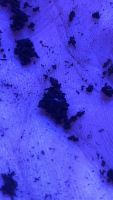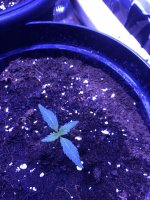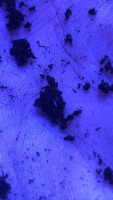Hi guys, second time grower, no problems the first time, but this time when watering in the morning I noticed tiny insects in the soil, very very smal and very quick... white in colour and under a mm in size, I think they also jump like ticks? Any ideas what they might be? Do i have to get rid of everything and start over??? Some pics that i managed to get of one of the bastards...
Navigation
Install the app
How to install the app on iOS
How To Use Progressive Web App aka PWA On 420 Magazine Forum
Note: This feature may not be available in some browsers.
More options
You are using an out of date browser. It may not display this or other websites correctly.
You should upgrade or use an alternative browser.
You should upgrade or use an alternative browser.
Bugs?
- Thread starter Rimas
- Start date
Edzzed
Well-Known Member
Better lighting too please.
Pbass
Well-Known Member
Actually after a bit more research, I think you have springtails!

Springtails.
Jeffrey Hahn, Extension Entomologist
Stephen Kells, Extension Entomologist
common soil springtail.
Photo: Le Requin
Folsomia candida, a very common soil springtail.
Springtails are one of the most common insects in the environment, although they are inconspicuous and are often overlooked. When suitable habitat occurs, they can develop tremendously large numbers and are one of the most abundant insects. One source estimates you may find millions of springtails naturally in one hectare (about 2.5 acres) of land. However, springtails can be a nuisance when they occur in and around homes and other buildings.
Springtail close-up
Photo: Le Requin
These insects are very small, commonly between 1/16th and 1/8th inch long. They have moderate length antennae and are usually slender, elongate insects, although there is a group of springtails that is round and stout. Most springtails are dark-colored, brown, grey or black although some species are white, and some are even iridescent and brightly colored.
Springtails are wingless and do not fly but they can jump, using a specialized forked appendage called a furcula, located underneath the abdomen. When not in use, the furcula is tucked under the body, set like a mouse trap. When it is released, it extends down rapidly propelling the springtail forward, jumping up to several inches.
Don't confuse springtails with fleas. While both insects are small, fleas are flattened from side to side and are very hard-bodied, making them very difficult to kill by crushing. Springtails have a more rounded body, are soft-bodied and are easily crushed.
Biology
Snowfleas
Springtails are associated with damp conditions and organic debris and are found outdoors in soil, leaf litter, lichen, under bark, decaying plant matter, rotting wood, and other areas of high moisture. They are found in many different habitats, feeding on fungi, pollen, algae, or decaying organic matter. Springtails are also commonly found in the soil of houseplants. However when conditions are suitable, you can also find springtails indoors, especially in bathrooms, basements, and kitchens.
Sometimes springtails can be found outside in the wintertime. Snowfleas, Hypogastruna nivicola, is a particular species of springtail; it is one of the few insects which can be found active on snow during winter. As soon as the ground begins to thaw in late winter or very early spring, snowfleas become active. Their dark colored bodies are conspicuous against the white background of the snow and they often congregate in large numbers. Despite their abundance, they are harmless.
Importance
The abundance of springtails in and around homes can vary from just a handful to very large numbers. Fortunately, regardless of their abundance, springtails are harmless to people; they do not bite or sting us. Rashes have been reported when people have been closely associated with large numbers, but it is uncertain if the skin condition is a result of the springtails or another agent that is typically associated with high moisture in structures. Springtails do not damage food products, clothes, furniture or any property. They are just nuisances.
Springtails that infest houseplants are found in soil that is excessively damp or in soil mixes contain a high percentage of peat. They feed on decaying roots and fungi and rarely, if ever, damage plants.
Management
There are several reasons why springtails may be found indoors. They are commonly found in areas of high moisture, e.g. around plumbing leaks, areas of condensation, and damp basements.
Sometimes the source of high moisture may occur outdoors. If excessively moist conditions occur near the home, that can encourage large numbers of springtails adjacent to the home which can then move indoors. High springtails numbers can be associated with mulch. It is also possible when it is excessively dry outdoors that springtails may move indoors to find moisture.
Springtails can also be found in the soil of overwatered houseplants and sometimes adjacent areas.
Nonchemical
If you are finding just a small number of springtails, just ignore them or physically remove them by hand or with a vacuum. However, if you are seeing persistent number of springtails, they are associated with a moisture problem. The best management is to dry out these areas with a fan or dehumidifier as springtails do not tolerate dry conditions. Also remove any wet wood, especially if it is moldy. Make any structural changes to correct the moisture problem. Springtails are generally a temporary problem and die when moisture levels are reduced.
If springtails are moving indoors from the outside, check around the house for moisture problems. This could include rainspouts that do not carry water far enough away from the foundation, landscapes that slope towards buildings, excessive irrigation, or non-functioning drainage systems around the building. It could even be a moisture problem with the roof. Correct existing moisture conditions to decrease the number of springtails. When necessary, remove or reduce the amount mulch that is around the foundation of your home.
If you have a problem with springtails in houseplants, let the soil dry out and water less frequently but more deeply.
Insecticides
Although it may be tempting to spray a springtail problem with an insecticide, the products available are generally not very effective against them. Moisture control is the most effective strategy.
Springtails.
Jeffrey Hahn, Extension Entomologist
Stephen Kells, Extension Entomologist
common soil springtail.
Photo: Le Requin
Folsomia candida, a very common soil springtail.
Springtails are one of the most common insects in the environment, although they are inconspicuous and are often overlooked. When suitable habitat occurs, they can develop tremendously large numbers and are one of the most abundant insects. One source estimates you may find millions of springtails naturally in one hectare (about 2.5 acres) of land. However, springtails can be a nuisance when they occur in and around homes and other buildings.
Springtail close-up
Photo: Le Requin
These insects are very small, commonly between 1/16th and 1/8th inch long. They have moderate length antennae and are usually slender, elongate insects, although there is a group of springtails that is round and stout. Most springtails are dark-colored, brown, grey or black although some species are white, and some are even iridescent and brightly colored.
Springtails are wingless and do not fly but they can jump, using a specialized forked appendage called a furcula, located underneath the abdomen. When not in use, the furcula is tucked under the body, set like a mouse trap. When it is released, it extends down rapidly propelling the springtail forward, jumping up to several inches.
Don't confuse springtails with fleas. While both insects are small, fleas are flattened from side to side and are very hard-bodied, making them very difficult to kill by crushing. Springtails have a more rounded body, are soft-bodied and are easily crushed.
Biology
Snowfleas
Springtails are associated with damp conditions and organic debris and are found outdoors in soil, leaf litter, lichen, under bark, decaying plant matter, rotting wood, and other areas of high moisture. They are found in many different habitats, feeding on fungi, pollen, algae, or decaying organic matter. Springtails are also commonly found in the soil of houseplants. However when conditions are suitable, you can also find springtails indoors, especially in bathrooms, basements, and kitchens.
Sometimes springtails can be found outside in the wintertime. Snowfleas, Hypogastruna nivicola, is a particular species of springtail; it is one of the few insects which can be found active on snow during winter. As soon as the ground begins to thaw in late winter or very early spring, snowfleas become active. Their dark colored bodies are conspicuous against the white background of the snow and they often congregate in large numbers. Despite their abundance, they are harmless.
Importance
The abundance of springtails in and around homes can vary from just a handful to very large numbers. Fortunately, regardless of their abundance, springtails are harmless to people; they do not bite or sting us. Rashes have been reported when people have been closely associated with large numbers, but it is uncertain if the skin condition is a result of the springtails or another agent that is typically associated with high moisture in structures. Springtails do not damage food products, clothes, furniture or any property. They are just nuisances.
Springtails that infest houseplants are found in soil that is excessively damp or in soil mixes contain a high percentage of peat. They feed on decaying roots and fungi and rarely, if ever, damage plants.
Management
There are several reasons why springtails may be found indoors. They are commonly found in areas of high moisture, e.g. around plumbing leaks, areas of condensation, and damp basements.
Sometimes the source of high moisture may occur outdoors. If excessively moist conditions occur near the home, that can encourage large numbers of springtails adjacent to the home which can then move indoors. High springtails numbers can be associated with mulch. It is also possible when it is excessively dry outdoors that springtails may move indoors to find moisture.
Springtails can also be found in the soil of overwatered houseplants and sometimes adjacent areas.
Nonchemical
If you are finding just a small number of springtails, just ignore them or physically remove them by hand or with a vacuum. However, if you are seeing persistent number of springtails, they are associated with a moisture problem. The best management is to dry out these areas with a fan or dehumidifier as springtails do not tolerate dry conditions. Also remove any wet wood, especially if it is moldy. Make any structural changes to correct the moisture problem. Springtails are generally a temporary problem and die when moisture levels are reduced.
If springtails are moving indoors from the outside, check around the house for moisture problems. This could include rainspouts that do not carry water far enough away from the foundation, landscapes that slope towards buildings, excessive irrigation, or non-functioning drainage systems around the building. It could even be a moisture problem with the roof. Correct existing moisture conditions to decrease the number of springtails. When necessary, remove or reduce the amount mulch that is around the foundation of your home.
If you have a problem with springtails in houseplants, let the soil dry out and water less frequently but more deeply.
Insecticides
Although it may be tempting to spray a springtail problem with an insecticide, the products available are generally not very effective against them. Moisture control is the most effective strategy.
PhobosAnomaly
Photo of the Month: Jan 2018

Spingtails are more of an eyesore, than a detriment.
Though they do stress the plants.
I have them often. Just do your best to let the plant dry out before watering.
There is no getting rid of them, and any chemicals or soaps will just cause stress.
I have sticky yellow pads on stake for them to climb when I water.
Lady bugs helped for a while but become a nuisance.
Diatomaceous earth might help, I have 10lbs and it hasn't fixed it yet.
Neem oil soap just stinks, they don't care.
With peroxide they jump and keep going.

Leaving some fruit or a potato on the soil while it drys, then tossing it helps.
I tried changing soil all together, and quarantined/cleaned tents.
Unfortunately I expect I will have to deal with them indefinitely.

Similar threads
- Replies
- 3
- Views
- 3K





